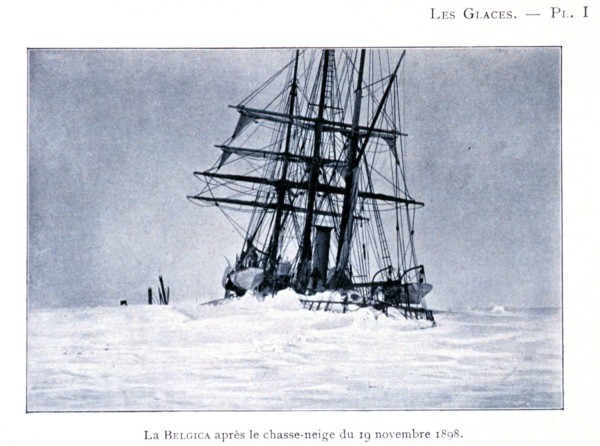Valmar Kurol’s latest CD, introduced first here at EWR in December, then later in Estonian Life, provided the spark. Kurol and Michael Stibor’s musical affection for the icy continent is presented in a lush and often surprisingly relaxing manner, proving that the frozen plains and mountains, icebergs are a wonderful source of inspiration.
The second occurrence was the arrival by mail of a travel pamphlet from Viking Expeditions. Apparently the undersigned, in another life (?) has traveled with these Norsemen and Valkyries, for the thick brochure had not only the name spelled correctly but also a passenger, client number. Frankly, cruises anywhere do not appeal at all. But a vapid interest in the brochure, triggered certainly by the ennui that is hard to alleviate these days resulted in a perusal of possible journeys. Surprise! Viking now will take you on a cruise of the Antarctic Ocean, making landfall at the international scientific station and with some exploration among other stops. Prices beginning from $19,495 for 13 days. Longer trips into the polar zone are also available. Airfare to Rio included, of course. (But. The rich of the 21st century are an ecological threat to Antarctica. The cruise ships belch effluents and the fragile ecosystem simply cannot bear the impact of bipeds, excepting penguins, of course.)
Advertisement / Reklaam
Advertisement / Reklaam
Then the third, this a happenstance in the local library. The new books shelf displayed a wonderful work about a marine attempt to reach the South Pole. Which ended up as the very first exploration that over-wintered in Antarctica, trapped in ice. The author is Julian Sancton, the title “Madhouse at the end of the World.” Published last year, it is the culmination of five years of a labour of love for the author, who first encountered the “Belgica” in a 2015 spring New Yorker article, which suggested that the historic event may provide lessons for space travel, notably to Mars. What is the difference? Mars or Antarctica? In the 19th century very little was known or even mapped about the seventh continent. The “Belgica's" scientists did much to fill in some blanks.This was, obviously yet quite curiously, a Belgian-led expedition. While most of us know about Roald Amundsen’s and Robert Scott’s competitive excursions onto the southern polar ice as well as Ernest Shackleton’s attempt, this writer knew nothing about the voyage of the “Belgica”. The commandant of that voyage, Adrian de Gerlache had been infatuated with polar exploration, and was over a number of years able to raise sufficient money to purchase a Norwegian whaler and outfit it as needed. The goal was to reach the South Pole. More difficult was the challenge of crewing the expedition. Patriotic Belgians wanted only their countrymen, but the reality was that Belgium, even with African colonies had no seafaring history, a risible navy (mostly ferries) and hence a tiny talent pool to draw from. De Gerlache was forced to hire beyond the available Belgians - Norwegians, Poles and even an American, Frederick Cook as the ship’s doctor. Cook was a key figure of inspiration and support on the “Belgica”. Later, however – and perhaps even then, – he showed his true colours as a fraudster, conman. Quite the charlatan, Cook claimed to have been the first to reach the North Pole. There is no proof, a lot of skepticism. Which is a shame, for history judges him for his post-“Belgica” deeds. Incidentally, the only undisputed claim to first seeing the North Pole was performed by Amundsen, although by air, not on foot.
Advertisement / Reklaam
Advertisement / Reklaam
Roald Amundsen was also on board. Along with Cook and the captain, Georges Lecointe the trio was the dynamo behind the exploration. The three formed The Order of the Penguin to distinguish themselves. And it was the penguins that saved “Belgica’s” crew – semi-raw penguin meat was eaten under Cook’s advice to combat scurvy.The “Belgica” is in the history books as the first international exploration, with so many nationalities on board. Belgium, or precisely de Gerlache, did not stake a land claim. As a result the continent is the only truly international one, owned by no country. Consider the “Belgica’s” crew. Cook spoke nothing but English. The Belgians French or Dutch. The Norwegians a smattering of German or English beyond their native tongue. It was truly a cosmopolitan undertaking; to even have an intelligible conversation was a success. But manage they did.
Sancton’s book is recommended. Meticulously researched, based on primary sources such as diaries, rather than dubious accounts from newspapers, rivals. (This is the only real way to write genuine history). It is a very educational read on many levels. Of course, you may become somewhat fixated, like three generations of de Gerlaches, many others, on Antarctica as well. Biographies and diaries of Scott and Amundsen may just be the start of a fascination, much like held by Scanton, and all the other explorers thus smitten.
The Estonian connection beyond Valmar’s lovely music? The Bellingshausen Sea. Where “Belgica” was trapped for over a year, February 1898 to March 1899. Sancton’s book has a wonderful map showing how the ship drifted in many different directions but in small areas of the famous sea. It was named after Fabian Gottlieb von Bellingshausen, born in Saaremaa in 1778, who became an Admiral in the Tsarist Navy. He participated in marine Antarctic exploration under Admiral A.J. von Krusenstern, also a Baltic German, born in Estonia (at Hagedi) in 1770, and died in Estonia, in Virumaa, while von Bellingshausen passed away in Kronstadt, Russia. Hence the naming of the sea after a naval legend from Estonia, be it as a Baltic German, the roots are and were significant.
Advertisement / Reklaam
Advertisement / Reklaam
A magical continent, Antarctica still beguiles many to this day from afar.TÕNU NAELAPEA
https://www.coolantarctica.com...
























